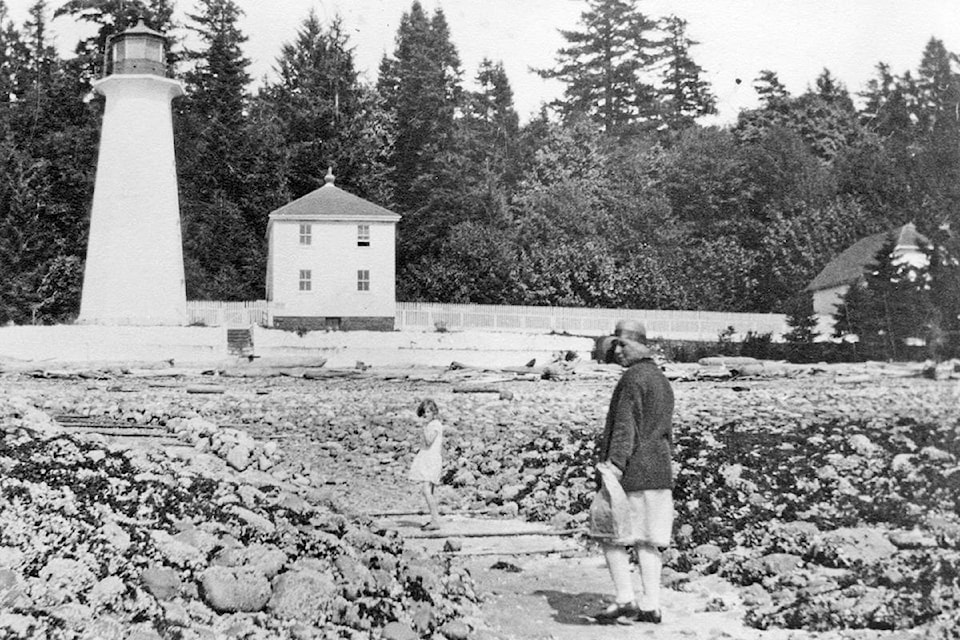By Erika Anderson,
Museum at Campbell River
Twelve metres tall. Tapered octagonal shape. Reinforced concrete, painted white with the top part red. Two foghorns protrude from an enclosed upper level window.
The design is simple, elegant, and fairly standard for buildings of this type.
It’s a building that anyone in Campbell River knows well from gazing across Discovery Passage towards Cape Mudge or Tsa-Kwa-Luten.
Shipwreck: June 17, 1890 – The Standard of Victoria foundered off Cape Mudge, leaving only the chief engineer to tell the sad story. The ship was struck by a heavy gale in the tidal rip off Cape Mudge at 6:30 in the evening. The steamer filled immediately, sinking stern first.
The first lighthouse was built in 1898. At this location, north and south tidal streams collide, creating strong tide rips, which when combined with the southeastern gales that happen each winter, can create conditions too dangerous for even the most seasoned mariner. Both before and since its construction, there have been multiple shipwrecks on the rocky shoals below it. As the Yukon gold rush intensified and ships began heading north in droves, the need for a lighthouse became more evident.
For the first 20 years, Scottish immigrants John and Annie Davidson were the light keepers at Cape Mudge. Initially there was only a hand-held foghorn, and a coal-oil lantern had to be kept lit on the roof beacon through the night. It was not an easy job and the couple took shifts on the 24 hour watch. In the book “Lights of the Inside Passage” they refer to this era as the “dark ages on the lights”, as women and children were expected to fill in as unpaid assistants and families were confined to their stations 24 hours a day without relief. In 1909, after 11 years on the watch, John Davidson left the station for the first time in order to go see an optometrist to address his failing eyesight. His request to be paid during this leave was denied.
Shipwreck: January 26, 1911 – Just after 2pm in a blinding snowstorm the Cottage City collided with a rock reef two miles south of the lighthouse. The ship was carrying passengers to Alaska and to the gold fields. The Davidsons guided the life rafts ashore and housed all of the passengers through the night. John Davidson, the light keeper, was credited with being “The hero of the Cottage City”.
The present station was constructed in 1916. It wasn’t until the 1950s that there was funding for an assistant for the lighthouse keeper, and by then the job had added so many new elements, such as frequent weather reporting, that it had become unmanageable for a sole paid keeper to maintain 24 hour watch.
The Davidsons did have it easier than many other lighthouse keepers, as their location was accessible to friends and neighbours so they did not have the same level of isolation common at many of the light stations.
Shipwreck: December 14, 1927 – The S.S. Northwestern ran aground at Cape Mudge in the early morning hours during a blinding snowstorm. Bound for Alaska, the ship was carrying 187 passengers and abundant supplies for the Christmas season. The raging storm prevented rescuers from evacuating the passengers for nearly 8 hours. There was considerable loss of property, but not a soul was claimed by the sea that night.
In 2015 the building was designated as a Heritage Lighthouse. It is a popular destination for locals and visitors alike. On a sunny day, breathing in the salty air and strolling along the driftwood-laden shore, it can easily be forgotten that the waters before you are hiding such dangers.
The lighthouse has stood at this place for well over 100 years providing a beacon of hope for mariners caught in stormy seas.
